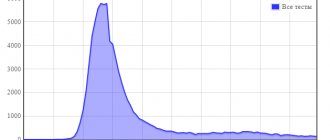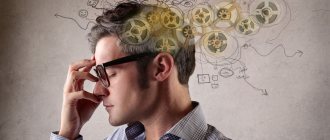Concept and brief history
What is cognitive science?
Cognitive science in the broad sense of the word means a set of scientific disciplines and studies that study intelligence and the ways of storing, acquiring, changing and using knowledge.
A narrow definition was given by Michael Eysenck. According to Eysenck, cognitive science is the interdisciplinary study of the application and acquisition of knowledge.
There is another definition, according to which cognitive science is an interdisciplinary complex of scientific areas that study cognition and higher forms of mental activity and thought processes.
Combines the results of research in the following sciences:
- psychology;
- philosophy;
- anthropology;
- theory of knowledge;
- neurophysiology;
- theory of artificial intelligence.
Cognitive science arose as a result of contrasting the theory of behaviorism proposed by the American psychologist John Watson.
Watson stated that only behavior should be studied from a scientific point of view; consciousness cannot be the subject of interest of science.
Since the beginning of the 1950s, Watson's theory has lost its title as the only correct one.
John Miller proposed that pieces of information are encoded and deciphered deep within the mind.
Later, scientists John McCarthy, Herbert Simon and others founded a field of science called artificial intelligence.
The term cognitive science was first used by Christopher Longuet-Higgins in 1973.
Cognitivism - what is it in psychology? Read about it here.
Cognitive science today
Modern cognitive science (or cognitive neuroscience) uses brain imaging methods that make it possible to experimentally prove the connection between mental phenomena and brain physiology. And if in the past traditional cognitive science did not take into account human consciousness, today’s cognitive science does not just take consciousness into account - it is one of the main objects of its research.
Perhaps the most important technical achievement that made the existence and development of cognitive science possible in general is innovative methods of brain scanning, for example, tomography. It was this, together with some other methods, that made it possible for the first time in the history of mankind to find out what the brain is from the inside, as well as to obtain unique practical information about its functioning, and not just indirect data, as was the case before. Of no small importance in this process, of course, is the development and creation of increasingly powerful computers.
If you try to divide all of cognitive science into parts, you will be amazed at how many components it contains. It includes cognitive psychology and cognitive linguistics, mathematical logic and artificial intelligence, material cognitive science and cognitive ethology, philosophy of mind and neuroscience, neurophysiology and neurobiology, as well as neurolinguistics, cognitive geography, cognitive anthropology, neuroscience and experimental cognitive psychology.
The progress that is currently being observed in cognitive science, according to scientists, can help humanity uncover the secrets that the mind hides within itself, in other words, describe in detail the processes occurring in the human brain and responsible for the activity of the higher nervous system. If humanity has such data, this will make it even more realistic and significantly accelerate the creation of artificial intelligence capable of possessing independent cognitive abilities, capable of creative activity and even full interaction with humans.
For now, all that remains is to monitor the development of this unique scientific direction.
We also recommend reading:
- Storytelling
- 10 Linguistic Concepts Everyone Should Know About
- Wundt's method of studying psychology
- Cognitive economics: the science of thinking
- Philosophical foundations of the linguistic concept of Wilhelm von Humboldt
- Theory of knowledge
- Game theory: history and application
- Cognitive psychology and cognitive psychotherapy
- The emergence of positivism
- Behaviorism: basic principles, representatives and directions
- Artificial Intelligence and the Turing Test
Key words:1Cognitive science
Famous cognitive scientists
There are a number of people in the world who have devoted themselves to the study of cognitive science, and they are rightfully recognized as experts in this field.
- Daniel Dennett is an American philosopher and cognitive scientist. During his long scientific career, he wrote many scientific works on consciousness and free will. In particular, he argues that will and consciousness are an illusion, they are the result of physiological processes occurring in the brain.
- Steven Pinker is an American scientist, psycholinguist, and psychologist. Pinker developed his theory of language acquisition. He wrote a book, widely known in scientific circles, “Language as Instinct,” in which he popularized the works of Noam Chomsky.
- George Lakoff is an American linguist and expert in the field of linguistics. He became famous as the creator of generative semantics.
- Jerry Fodor is an American philosopher and experimenter in the field of psycholinguistics. Developed a theory about the language of thought.
- David Chalmers is an Australian philosopher and cognitive scientist. The area of specialization concerns the philosophy of mind and language. Chalmers formulated the concept of the problem of consciousness.
Notes
- Adapted from Miller, George A (2003). “The cognitive revolution: a historical perspective.” Trends in Cognitive Sciences 7
. - I. P. Merkulov.
Cognitive Science // Encyclopedia of Epistemology and Philosophy of Science / Compilation and general editing. I. T. Kasavin. - Moscow: “Canon+” ROOI “Rehabilitation”, 2009. - P. 364-365. — 1248 p. — 800 copies. — ISBN 978-5-88373-089-3. - Antti Revonsuo.
Chapter 2. Historical foundations of the science of consciousness // Psychology of consciousness / Translation: A. Stativka, Z. S. Zamchuk. - St. Petersburg: Peter, 2013. - pp. 89-90. — 336 p. - (Masters of Psychology). — ISBN 978-5-459-01116-6. - Adriana Alcaraz.
Cognitive.cat.
cognitive.cat
. Cognitive.cat (08/25/2015). (unavailable link) - Embodied Cognition // The Stanford Encyclopedia of Philosophy / Robert A. Wilson and Lucia Foglia
Classic methods at its core
Cognitive science is based on two classical methods.
The first method is called symbolism . The main idea of the method is the similarity between human mental activity and computer thinking. The computer has a central processor in which all incoming information is processed. Man has a similar structure.
The second method is called connectionism . Completely contradicts the first method.
Human thinking cannot be compared with the thinking of a computer processor, so neurobiological data on brain activity refute this statement.
Artificial neural networks can stimulate human thinking.
You can find a list of cognitive disorders on our website.
Cognitive science and ways to optimize the creative process
Speaking on the topic of ritualization of creativity, the cult writer Charles Bukowski mockingly said that “neither light, nor air, nor time, nor space can affect the abilities of the author.”
The English literary critic Samuel Johnson held a similar point of view: in his opinion, a writer is able to work at any time and in any weather, but only if he can force himself.
However, there are many cases in history when authors who achieved worldwide popularity and fame, in an effort to improve their efficiency, adhered to a special daily routine and even invented special rituals.
Cognitive psychologist Ronald T. Kellogg, in his monumental work The Psychology of Writing, took the existing strategies of pen and ink writers and tried to explain how daily routines, rituals, and environment can affect the quality of work.
He's writing:
“There is evidence to suggest that environment, routine, and ritual (habitual) activities can enhance productivity and efficiency, enhance focus, and reduce attentional entropy.
These factors can cause a certain emotional state in which working will be much easier and more enjoyable. Moreover, such states can awaken in your mind specific ideas, plans, facts that you associate with place, time and other things that are somehow related to your work.”
The Daily Routine of a Typical Writer
The scientist had to go through an impressive list of studies in order to formulate several very important conclusions. Among them is the role of background noise, which, paradoxically as it sounds, can have not only a negative impact on your creative abilities.
For example, high-intensity noise (over 95 decibels) will have a destructive effect on the performance of complex tasks, but will help maintain concentration when performing tasks that are monotonous and boring, devoid of creativity.
The correlation between skill level and task difficulty also contributes: if you feel that you are beyond your ability to complete a particular task, the noise will become increasingly annoying.
- Lighting, temperature and noise level - how to optimize your workplace and increase creativity?
Kellogg also suggested that modern writers suffer from excessive anxiety, which, as you might guess, only increases in a noisy environment.
The scientist drew attention to a number of studies indicating that a work session lasting from 1 to 3 hours with breaks is most conducive to increasing productivity, not only for writers, but also for musicians, artists and athletes.
He also mentions a study of circadian rhythms in 1985 (circadian rhythms (from Latin circa - around, around and Latin dies - day) - cyclical fluctuations in the intensity of various biological processes associated with the change of day and night): in the morning hours, work on With complex, creative tasks it is most effective, but by the evening it decreases. The greatest writer Hemingway, intuitively guessing about this, noted in some interviews:
“When I’m working on a book or a story, I sit down at my desk as soon as the light begins to shine outside the window. I usually work from 6 am until noon. At this time, no one will disturb you, and the cool air will only help you get back to work faster. In addition, I always finish writing at the point when it is obvious to me what will happen next. In the morning I read this fragment and am easily involved in the action of the work.”
Ernest Hemingway at work
The environment also plays an important role in maintaining a long and productive workflow. Famous musician Bob Dylan, for example, extolled the ability to “be able to create conditions in which you can accept the results of your subconscious without interference.”
- Creative activity during the day - is there a pattern?
Kellogg's conclusions echo the memorable statements of William Faulkner, the famous American novelist: “The only thing a writer needs is solitude, and that is the little that will cost him little.”
Kellogg also notes that writers try to find a quiet and secluded place for their work, although “during the student phase, almost any environment becomes acceptable”: not everyone can afford a full-fledged workplace, and the energy of a young body is abundantly enough to maintain concentration and creative performance even in noisy environments.
This phenomenon can be reconceptualized in terms of the cognitive concept of encoding specificity.
Abstract ideas, images, plans, concrete sentences, emotions and everything else that may represent information necessary and useful for writing a text turn out to be related to the environment, namely, the time and place that the writer chose to engage in creativity.
Accordingly, all this information, deposited in the subconscious, is activated at the moment when the writer again finds himself in his usual workspace. After he concentrates on the ideas coming from the subconscious, the creative process completely captures him.
It should be said that the method outlined above is also used in the treatment of sleep disorders, namely, a sleep schedule is introduced (going to bed is carried out at the same time), and a special washing place is organized where the person prepares for the upcoming rest. It is no coincidence that writers also try to adhere to a special routine in order to optimize their rest and the time they spend on it.
Kellogg also cites a treatment program developed by psychologist Bob Boyce for anyone whose professional activity is somehow related to writing:
“The key to Bob Boyce's program is the redesign of the writing environment. To work on serious things (novels, stories, articles), he suggests organizing a special workspace.
Other small tasks (processing incoming correspondence, for example) should be moved to another location. Boyce also insists that magazines, books and other sources of information that are not essential for work should be removed from view, and social contacts should be minimized or completely eliminated.
By following these simple tips, a writer can create a special space dedicated only to thinking and writing. Thus, this place turns out to be connected with all the “mental products” of the author and each time becomes the starting point for his further creative research.”
Please note that this technique was created long before the advent of smartphones and social networks with their annoying notification services for new messages. Naturally, when organizing a special workspace, all these modern means of communication should also be excluded.
Thomas Mann, the famous German writer, wrote:
“To work, I need a roof over my head, and since I like to work by the sea, I will also need a sun lounger or a wicker chair. Most of my creations were conceived while walking; I also find that being outdoors fuels my passion for writing and writing. When I work on large works, I always use developments from my literary practice, which are always at hand.”
In the final chapter, Kellogg says:
“The variety of options for organizing work environments indicates the flexibility of human thinking. A person can work in any conditions, although, admittedly, some prefer particularly extravagant options. The main thing is to find (create) an environment for yourself that will allow you to concentrate your attention on the task as much as possible and achieve high productivity.”
Conclusion
Admittedly, these strategies alone certainly won't help you win a Pulitzer Prize or write a bestseller. Ultimately, there are many components to any success, but your work ethic and integrity are perhaps among the most important.
High conversions to you!
Based on brainpickings.org, image source hablandodelasunto3, Vinoth S Ratnam
29-09-2014
Application of knowledge in practice
Knowledge of cognitive science is widely used in practical activities .
Cognitive psychologists can help people with brain problems or dysfunctions. An individual treatment program is developed, as a result of which the person’s natural processes in the brain are restored.
Cognitive science makes it possible to create the right methodology for children to learn languages or other subjects that require the active functioning of parts of the brain.
Website developers can take advantage of the accumulated knowledge of cognitive science. When placing an advertisement, it is important for the site owner that the advertising post is immediately noticed by a person, and he would be interested in the proposed option.
For this purpose, it is necessary to understand what kind of organization human attention and perception has, and to study eye movements.
Cognitive science knows the answers to these questions, and this helps website owners place advertising to their benefit .
TV advertising customers work on the same principle.
Ideally the development of diseases can be prevented if scientists understand the mechanism of how to send signals to the brain so that it does what the body needs to function normally.
Literature
- Langakker R. U. Cognitive grammar. - M.: INION RAS, 1992. - 56 p.
- Lakoff J. Cognitive modeling. Language and intelligence. - M.: "Progress", 1996. - 416 p.
- A brief dictionary of cognitive terms. / Under general ed. E. S. Kubryakova. - M.: Philol. Faculty of Moscow State University named after. M. V. Lomonosov, 1997. - 245 p.
- Velichkovsky B. M. Cognitive science: foundations of cognitive psychology. In 2 vols. - M.: Sense: Publishing House, 2006.
- Cognitive science and intellectual technologies: Ref. Sat. Academy of Sciences of the USSR. - M.: Institute of Science. information by society Sciences, 1991. - 228 p.
- Dennett D. Ontological problem of consciousness / Transl. from English A. L. Blinova // Analytical philosophy: Formation and development (anthology) / Comp. Gryaznov A.F. - M.: DIC "Progress-Tradition", 1998. - P. 361-375.
- Churchland, P. S. (1986) Neurophilosophy: Towards a Unified Theory of the Mind Brain, Cambridge, Massachusetts, Bradford Books/MIT Press
- Fodor, Jerry (1998). Concepts: Where Cognitive Science Went Wrong. New York: Oxford University Press
- Jackendoff, R. (1987) Consciousness and the Computational Mind, Cambridge, Massachusetts, Bradford Books/MIT Press
- Pinker, S. (1997). How the Mind Works. presented at the New York, New York: WW Norton & Company
- Varela, F., Thompson, E. and E. Rosch (1991) The Embodied Mind: Cognitive Science and Human Experience, Cambridge, MA: MIT Press










